Analysis of the application possibilities of smart methods and technologies in the system of urban loading areas
Previous phases of the project were funded under the EFOP-3.6.3-VEKOP-16-2017-00001 program: “The research was supported by the Hungarian Government and co-financed by the European Social Fund through the project “Talent management in autonomous vehicle control technologies” (EFOP-3.6.3-VEKOP-16-2017-00001).“
Members of the project: Nóra Ráduly (MSc student), Janka Tihanyi (MSc student), Krisztián Bóna (supervisor), Dávid Lajos Sárdi (supervisor)
Past members of the project: Aletta Büki, Viktória Domaniczki, Boglárka Szeredi
Start of the project: September 2020
In the examined city logistics systems, three main junctions are to be considered: the consolidation centers, the cross-docks, and the commonly usable (“common”) urban loading areas. Regarding the sizing of the consolidation centers, it can be defined as a simple warehouse planning task; with cross-docks, we conducted research earlier, resulting in a master’s thesis and a scientific conference paper. Therefore, in this research, we are investigating the urban loading areas in detail.
Up to this point, we examined the domestic approach (no entry areas, urban loading bays), specifically the “Váci utca” shopping area in Budapest, which we had detailed information about from recent projects topological data, and about its city logistics characteristics. Besides, we examined practices in multiple other domestic and foreign cities (like Győr, Barcelona, or Stockholm).
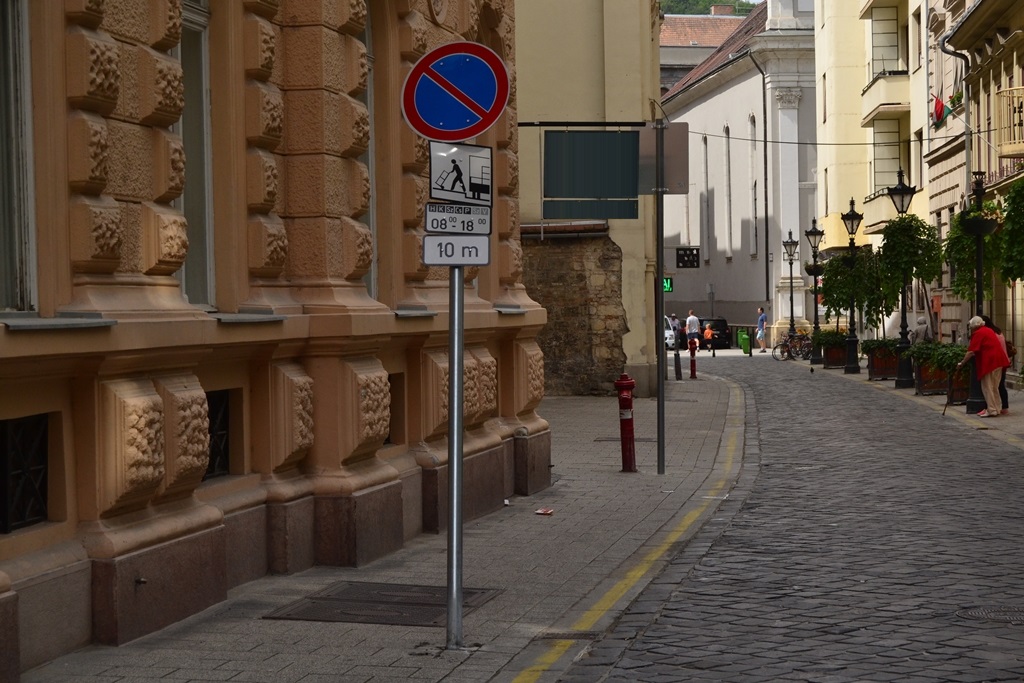
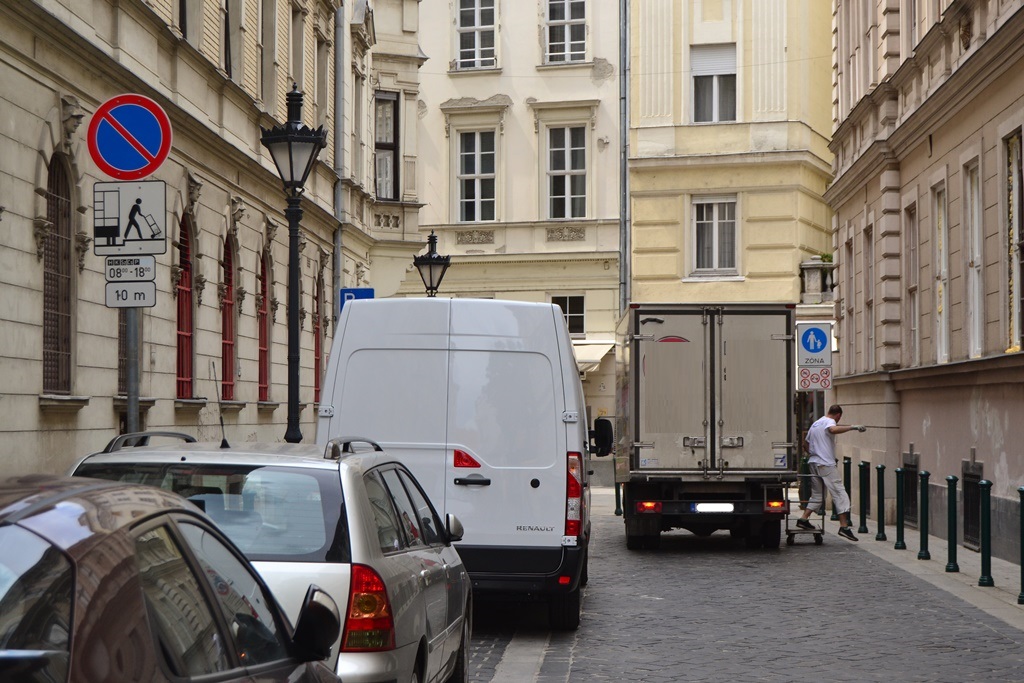
The common loading bays in Budapest
After this, we managed to patch the problems that can occur in a system. We concluded that in the case of Budapest, the main concern is that the regulation of logistics processes isn’t consistent, the record of urban loading areas isn’t refreshed regularly, and the control system is somewhat omitted.
By the results of the first phase of our research, we can confidently state that setting and managing urban loading areas is a complex task. The question „Is it necessary to maintain urban loading areas at all?” was also unearthed, so we not only examined the problems created by these locations but looked for alternative solutions (like solutions using drones, package vending machines, and loading tunnels).
In the next step of our research, we mainly focused on urban shopping areas; we enquired how it is possible (by integrating different intelligent technologies) to improve the common loading areas. In the framework of this project, we collected all the functions required to assist in effective loading and delivery processes. With these functions and unearthed problems, there is huge room for improvement in numerous areas. Among these functions, new possibilities arose, such as applying autonomous vehicles or drones; however, researching the possibility of using these devices has just started. The result of the project got defined as a 4-step program, by the main functions and the order of implementation:
-
- Urban loading areas can only be used for loading (no temporary parking space)
- Along with loading goods, it must be possible to record data
- Further functions, such as serving electronic vehicles and providing temporary storage
- Loading bays are accessible by drones and autonomous vehicles

Steps of the solution
For improving urban loading areas, one needs data collection of adequate depth, which can be acquired through a survey inspection. Therefore, a survey was created, in which not only the stores but the logistics providers’ and vehicle drivers’ requirements can be logged. The data gained this way can serve as a basis for investigating loading area concepts. We plan to test these concepts in practice, which might be possible in the Smart City Zone, which can be found in the test track of Zalaegerszeg.
Along with these, another important subject of this research is the sizing of the urban loading areas; one must estimate the optimal number, capacity, and location of the loading bays. To define the optimal number and locations of urban loading areas, we consolidated data from earlier research on the “Váci utca” shopping area, brought to adequate condition for planning, to prepare data for the full sizing of the area. After that, we worked out a solution method for the problem. We solved it through clustering and centrum-search algorithms for different numbers of loading bays, taking the distances into account. The method has been tested for multiple scenarios, results are pleasing, but we will need further elaboration.
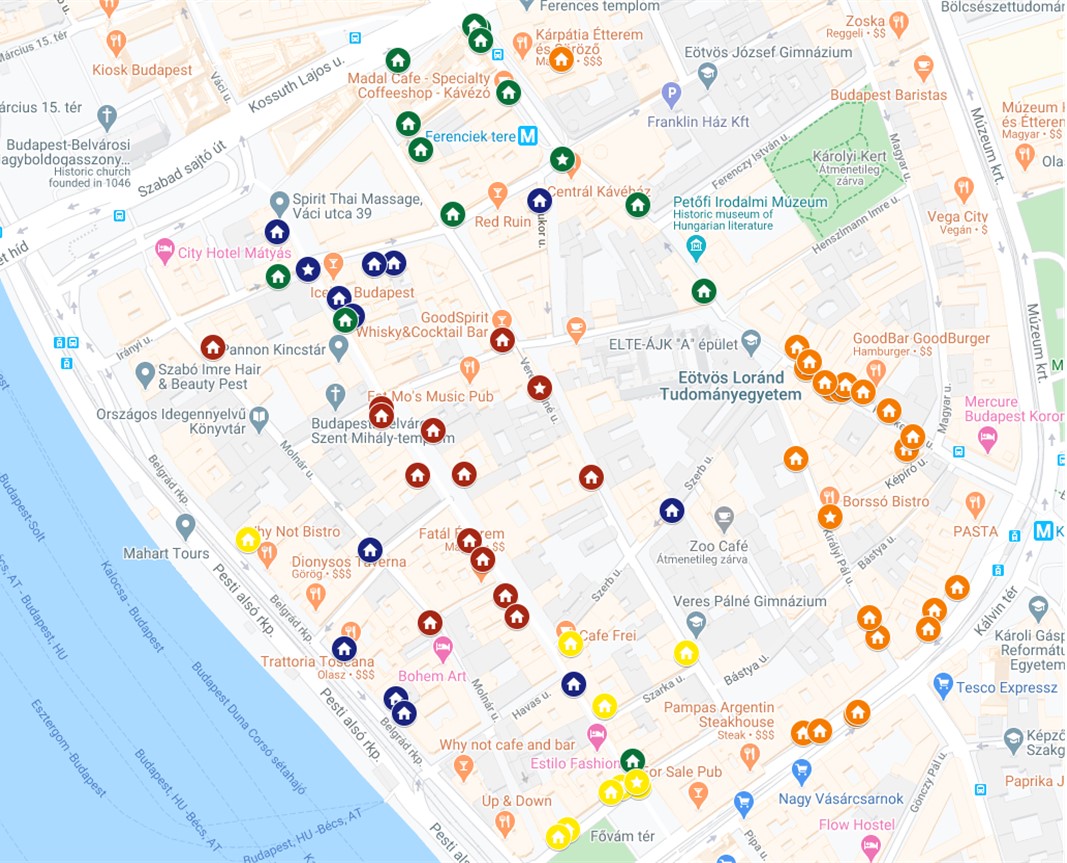
Loading bays and stores assigned to them in the “Váci utca” shopping area, applying our solution method (for five loading bays) on Google Maps
The research has outlined the primary bottleneck in the examined system: the lack of data. Optimal system design is impossible without adequate data and data structure, so the next step in the research was the conceptualization of the electronic loading disc concept, which on the one hand, should fill the data gap in this area and, on the other hand, it is an excellent opportunity to improve the current loading infrastructure. The concept of the electronic loading disc is designed to replace the traditional loading disc currently in use with more modern service. The data it could collect could be used to develop a new network structure and introduce services for customers in the future. In this context, a preliminary database structure and a conceptual design for the user interface of the phone application have been prepared. In the implementation of the application, it was considered important to create a solution that was as simple and user-friendly as possible and to add to the application’s functionality in the future to extend its services as much as possible. The figure below illustrates how we can move from an electronic version of the current loading solution to an application that shows the occupancy of loading bays in real-time, allows us to pre-book shared loading bays, and even organize joint, consolidated transport with other companies.
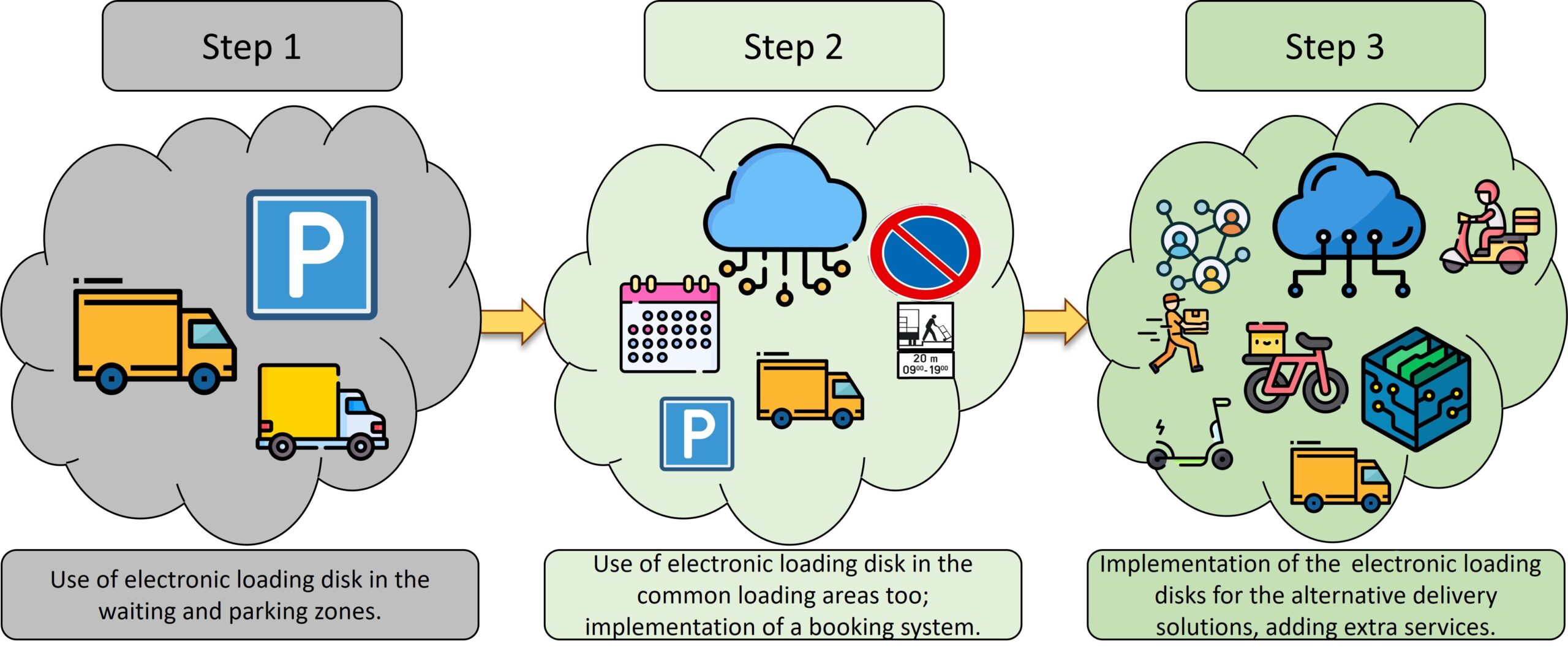
Extension of the functions of the electronic loading disk
Feasibility also played an important role in the development of the concept, so the details of this were developed in the research. In addition, several city logistics concepts have been developed that could be used to replace the current traditional loading bays.
In the next step of the research, the needs of drivers involved in the examined city logistics systems in Hungary and the problems they face were also surveyed using a questionnaire. This revealed that they also directly perceive the problems, the inadequate location, number, and capacity of the loading areas, and the lack of knowledge about the possibilities of using loading disks. At the same time, they are regularly hindered in their tasks. Considering these and the problems identified earlier, a detailed concept for a smart loading bay has been developed.
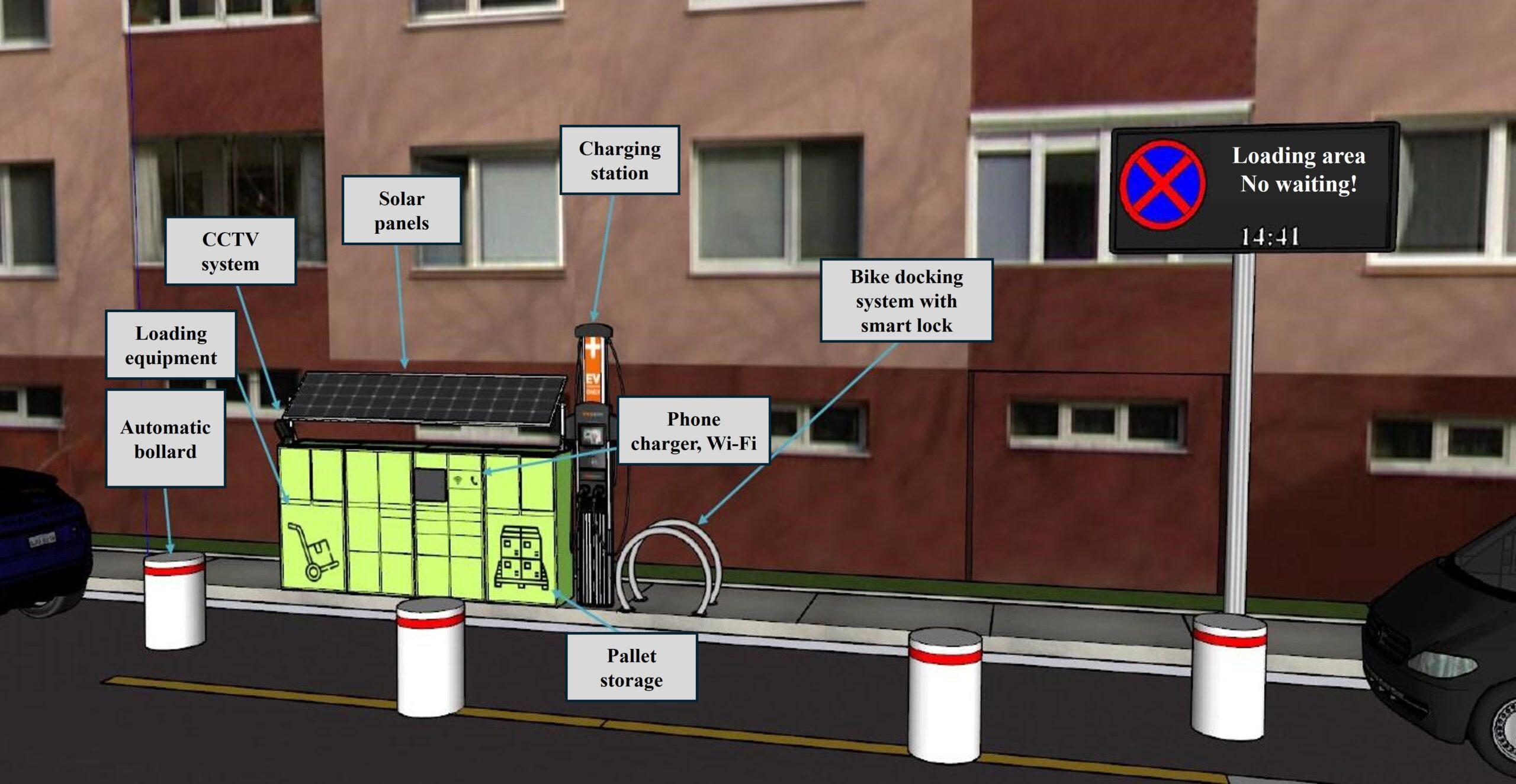
3D concept of an intelligent loading area
The following research phase extended the methodology to study the signed loading areas. Previously available methods did not focus on the loading processes themselves, but rather on the store and driver side, as well as on the physical parameters and topology of the loading areas, but these data alone are not sufficient to design an optimally functioning network of loading areas, so a new measurement methodology was developed. The use of the measurement methodology allowed to fill the gap of this data, i.e., the characteristics of the loading processes regarding time, the units moved, and the loading processes themselves could be measured so that a complex design using the measurement methodology will be possible in the future. The methodology has been tested on several loading areas in the center of Budapest, in the Váci utca shopping area, and along the Nagykörút. As can be seen in the figure below, the measurement methodology completes the data collection methodology for the study of urban loading areas.
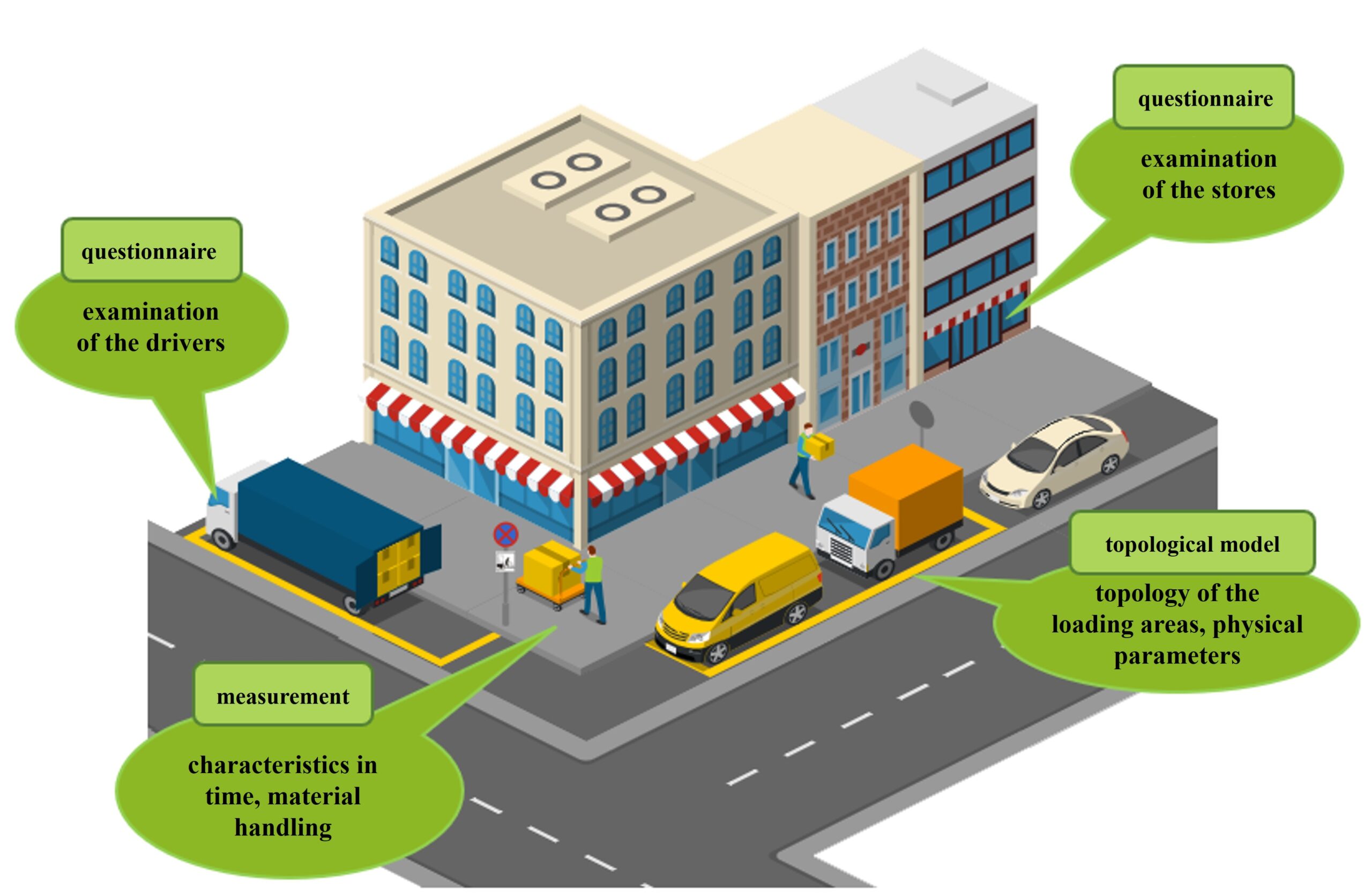
The complete methodology to examine the urban loading areas
Significant documents related to the project
Krisztián Bóna, PhD, Dávid Lajos Sárdi, Aletta Büki, Viktória Domaniczki. Intelligens eszközök jövőbeli szerepe a városi koncentrált rakodóhelyek rendszerében – The future role of the smart devices in the system of the urban concentrated loading areas (2021).
XV. Innovation and Sustainable Surface Transport (IFFK) 2021, Budapest, online.
URL: https://mmaws.bme.hu/2021/pages/program/papers/IFFK_2021_Paper_01_Bona-Sardi-Buki-Domaniczki.pdf
ISBN: 978-963-88875-5-9